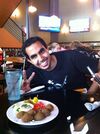BME100 s2015:Group18 12pmL1
| Home People Lab Write-Up 1 | Lab Write-Up 2 | Lab Write-Up 3 Lab Write-Up 4 | Lab Write-Up 5 | Lab Write-Up 6 Course Logistics For Instructors Photos Wiki Editing Help | |||||||
|
OUR TEAM
LAB 1 WRITE-UPIndependent and Dependent VariablesThe independent variable is amount of LPS (lipopolysaccharide) given as a dose to the subjects because we are trying to determine the lowest amounts to use to induce inflammotin. The dependent variable is levels of Inflammotin in test subjects. This is the dependent variable because its levels are directly affected by the amount of LPS, the independent variable. Experimental DesignGroups Group2: 1mg LPS Group3: 2mg LPS Group4: 3mg LPS Group5: 4mg LPS Group6: 5mg LPS Group7: 6mg LPS Group8: 7mg LPS Group9: 8mg LPS Group10: 9mg LPS Based on the results of prior work, we know that 10mg of LPS elicits an increase in Inflammotin, so we decided to create ten groups of doses of 0-9mg to see the lowest level of LPS needed to increase Inflammotin. We chose to create a group for every milligram of LPS in order to find at which precise dosage the LPS would begin to increase Inflammotin levels. Each group will have five women and five men. Approximately half of the women will be in the 'small' weight (<= 170 lbs) category and the other half will be in the 'big' weight (>= 180 lbs) category. The same goes for the men with the 'small' weight group being in the <= 190 lbs and the 'big' weight group being in the >=200 lbs. Half of the women and men will be in the no exercise group (no exercise for at least 2 months prior to the LPS administration. Half of the women and men will be in the exercise group (doing at least a small amount of exercise each and every day for at least two months prior to the LPS administration. Age
There will be a total of ten subjects per group, because there should be at least seven subjects per group. The subjects will be both male and female.
Subject Selection- Subjects gathered through flyers, internet, and newspapers. - Random selection mitigate bias potential. - Over the age of 60. - Take both men and women. (Gender control) - Diverse race representation within groups. (Race control) - Exclude subjects with major blood or heart-related medical problems. - Exclude subjects taking anti-inflammatory medication. - Subject size: Both small and large
women(small<170, 180<large) men(small<190, 200<large) In between the two ranges is the average.
Sources of Error and BiasOne source of error is the presence of medical conditions in the elderly subjects that may inhibit production of proteins such as Inflammotin, therefore reflecting different effects of LPS on Inflammotin levels. Subject selection will attempt to seek subjects absent of major blood or heart-related medical problems (heart disease, blood clotting disorders, previous history of heart attacks, etc). Another source of error is blood type differences, which may change the effect of LPS on Inflammotin levels. To potentially control this error, groups could be made based on blood type to see if the type of blood has any effect on the medication's ability to increase the Inflammotin protein. A third source of error is if subjects are currently taking other medication which may change the effects of LPS on inflammotin levels. Due to the elderly necessity to take medication, the subject selection process will attempt to seek only subjects not taking any other anti-inflammatory medication (Advil, Ibuprofen, etc) which could potentially interfere with the results of the LPS. Another potential source of error is if the participants in the experimental groups do not take their pills properly. This can be controlled by monitoring the groups to make sure the drugs are taken properly. The fifth source of error is size/weight of the patient. A small (underweight) patient will require less LPS as compared to a bigger (overweight) patient which would require more LPS to do the same effects. The way to control this in our study will be to separate the women into 'small' and 'big' groups and the men in 'small' and 'big' groups as well. The sixth source of error is lifestyle (exercise habits) of each patient. Everybody has different levels of exercise habits and fitness. So to control this we need to separate the patients into those that consistently do exercise and lead a healthy lifestyle and those that do not exercise. The seventh source of error is genetic factors (some people are predisposed to inflammation history). So to control this we will ask the patients if they have a history of inflammation. The eight source is other drugs the patient takes for other issues that could have an inflammatory effect. To control this we will separate the patients into groups that are half on normal medications (high blood pressure, diabetes, etc.) and the other half on absolutely no medication whatsoever.
| |||||||





